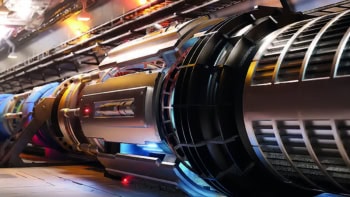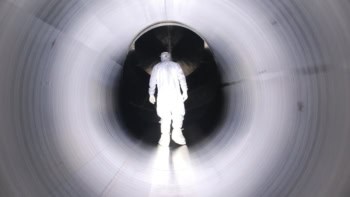When he takes charge of the world’s largest physics laboratory next January, Rolf-Dieter Heuer will begin work just as the long-awaited Large Hadron Collider reaches full throttle. Matthew Chalmers finds out what CERN’s next director-general plans to make of his rather fortunately timed five-year term

When the Economist recently reported the news of Rolf-Dieter Heuer’s appointment as the next director-general of CERN, it depicted him sitting cross-legged in the middle of a circular track steering a model train around him — smiling. It was an apt cartoon for someone who is about to take charge of the world’s most powerful particle accelerator: the 27 km-circumference Large Hadron Collider (LHC), which is nearing completion at the European laboratory just outside Geneva. What the cartoonist did not known is that model railways are one of Heuer’s passions.
“I don’t ‘play’ with the trains,” the 59-year-old German particle physicist is quick to point out over the phone from his office at the DESY laboratory in Hamburg, where he is currently director of high-energy and astroparticle physics. “I like to build complex track arrangements — and not just circles!”
From January 2009 Heuer will have a somewhat more complicated toy at his disposal. The LHC, which is due to start tentatively smashing protons into one another beneath the Franco-Swiss border this summer after 23 years of planning and construction, is the largest scientific instrument ever built. When it reaches full throttle next year, the multibillion Swiss Franc accelerator will pack an energy of a few TeV (1012 eV) into a volume of about 10–45 m3. Such conditions have not existed since the first trillionth of a second after the Big Bang, which means that the LHC could open the door to particles and forces that have never been seen before. The timing of Heuer’s five-year directorship could hardly be better.
Is he nervous? “No. I am looking forward to the job, but with a certain respect. It carries much more responsibility than I’ve ever had,” he says. “The future of CERN and of particle physics depends on the outcome of the LHC.”
Management material
Heuer is certainly no stranger to CERN. In 1984, following a PhD and a postdoc at the University of Heidelberg, he joined the laboratory as a staff scientist with responsibility for part of the OPAL experiment — one of four large detectors positioned around the Large Electron Positron collider (LEP), the LHC’s predecessor. His skills, he says, were not so much in data analysis but in handling, talking to and driving people. By 1994 he had been appointed spokesperson for the 330-strong OPAL collaboration, although he never imagined he would one day become CERN boss.
Heuer took up his current position at DESY in 2004. One of his main tasks there has been to steer the closure of the lab’s electron—proton accelerator HERA, but he also had to decide on what the German lab should do next. “That was not very difficult,” he recalls. “It was absolutely clear that the future was in the LHC.” Although criticized at the time for choosing to spread finite resources between both ATLAS and CMS — the two largest of four giant particle detectors at the LHC — that decision has put him in good stead for his new role.
“It is simply great to have the chance to oversee this unprecedented era at the world’s biggest lab,” says Heuer with palpable excitement. “I didn’t make any active steps towards this position [as candidates for the role of director-general must be proposed by others], but I think people want a particle physicist in charge now.” The incumbent director-general, Robert Aymar, is a plasma physicist by training, although he was involved in the LHC long before he took up the position and also helped develop the superconducting-magnet technology that will guide protons around the machine.
Most particle physicists know what they would like to see most among the billion or so collisions that will take place each second in the LHC’s two main detectors. All eyes are on discovering the Higgs boson, which would prove that mass originated in a phase transition in the very early universe during which the electromagnetic and weak nuclear forces decoupled. This would be the icing on the cake for the Standard Model of particle physics, which is based on the unified electroweak theory and therefore deals with massless particles.
Exotic new “sparticles” are another target of the LHC, which if discovered would reveal another fundamental symmetry of nature called supersymmetry and hint at physics beyond the Standard Model. Miniature black-holes might even appear, and the wavefunctions of ordinary particles will be squeezed into such small spaces that they may disappear into a compact extra dimension. Then again, something unimaginable could happen when the LHC’s proton beams collide — perhaps even nothing at all, thereby forcing physicists to rewrite nearly four decades of research into high-energy physics.
Heuer takes a pragmatic view. “Something has to turn up at the TeV scale [otherwise there is something wrong with the whole edifice on which the Standard Model is built], so the best scenario for me is that that something will be easily detectable,” he says. “The worst-case scenario will be if something takes years to be resolved, because then we will have to defend the LHC to politicians looking for hard results.”
An open approach
The LHC has already received huge media exposure, and CERN will find itself under the spotlight even more when the data start to pour in next year. A major challenge of his job, Heuer predicts, will be to decide when a discovery should be announced. “A nightmare situation would be to announce a signal that later turns out to be a false alarm,” he says.
Heuer’s problem is that it could take several years before the cathedral-sized LHC detectors are well enough understood for the data to be trusted. Then he has to deal with the nuances of statistics. Unlike hunting for a needle in a haystack and then stopping when it turns up, physicists searching for particles like the Higgs will have to distinguish as many sightings as they can from a vast number of similar “background events” and phrase their findings in the language of probability.

On top of all this, the new director-general will have to contend with the ambitions of the 2000 or so researchers working on each of ATLAS and CMS, and as many again working on the ALICE and LHCb experiments. With many physicists hoping to either launch or crown their careers with an important discovery at the LHC, it will be difficult to ensure that exciting new results are not announced via an individual’s host institution or “blog” before being properly scrutinized. Last year, CERN’s US counterpart Fermilab issued specific guidelines on this point after a member of the CDF collaboration posted an unapproved result on his blog. Although Heuer has enormous confidence in the physicists at CERN and thinks that the rivalry between ATLAS and CMS is healthy, he expects he will have to implement similar measures. He also says CERN should be prepared to announce bad news as well as good, ideally along with an indication of how any such situation would be resolved. This does not appear to have been the approach adopted by CERN in March last year, when Fermilab was left to communicate the impact of a magnet failure on the LHC schedule, even if it was the US lab that had designed and built the faulty magnet.
In Heuer’s opinion, the key to managing the information flow is to establish an open, yet confidential, relationship between the experiments and CERN management. He attributes poor communication as the cause of one of the more bitter moments in CERN’s recent history. This involved an unpopular decision by the laboratory management to press ahead with the planned closure of LEP at the end of 2000 in order to make way for the LHC, which was to be built in the same tunnel, just when the Higgs seemed to be peeking out from the data. Although Heuer says the decision to close LEP was probably the right one, he thinks some of the hostility could have been avoided if staff had been better informed of the thinking of the management.
Physics or bust
If everything goes to plan, the LHC will be upgraded in about 2015 to allow more proton collisions to take place. But Heuer expects to have to decide on the specifics of this upgrade, which will depend critically on what turns up at the LHC and on how well the accelerator itself performs, towards the middle of his term. Taking Aymar’s experience as a guide, he could be in for a few surprises. “From day one I was dealing with unforeseen problems that eventually cost us a year’s delay and a lot of money,” explains the incumbent director-general. “But this is inevitable with a project as complex and unique as the LHC, and overcoming such problems is one of the rewards of the job.”
Heuer says CERN cannot put all its cards on an LHC upgrade, but must also continue to invest in the Compact Linear Collider (CLIC) — CERN’s bid for a high-energy electron–positron collider that would allow the particles that appear at the LHC to be studied in more detail. He also thinks CERN should become more involved in the International Linear Collider (ILC), which would use existing technology to achieve the same goal but would be more limited in energy.
With several major labs winding down their programmes and recent funding cuts in the UK and US denting the ILC effort, CERN could be in danger of dominating the high-energy-physics landscape. “It is difficult to imagine an international project being realized in the US now, so CERN should capitalize on its reliability to ensure the future of the field,” says Heuer, who would also like more networking to take place between the big labs. As for the UK’s “strategic” decision to pull out of the ILC, Heuer finds it incomprehensible, given that the R&D necessary to determine the project’s viability is still being undertaken.
Passing the baton
Particle physicists the world over are in for an exciting decade. Having nursed the LHC to completion on a tight budget, Aymar is naturally disappointed to leave before the results arrive and says that he would have been happier to stay in the job for three more years. Meanwhile, Heuer is in the “collecting phase” during which he plans to find out how all levels of CERN staff and users view the laboratory and its standing. He will then come up with a management structure and propose people to fill it, as all incoming director-generals are free to do.
“Heuer knows CERN well, and is an ideal choice to lead the laboratory during this cycle of the scientific process where the baton will be passed from theory to experiment,” says LHC project manager Lyn Evans.
Many physicists have asked Heuer to remain as he is when faced with the reality of the role — something he thinks he has so far managed when becoming spokesman of OPAL and research director at DESY. “I think that what will help me most is that I have the ability to listen to people and to take everybody seriously,” he says. And will he be packing his model trains when he moves to Geneva in January? “Yes, but I don’t expect to have time to use them.”
In person
Born: Boll, Germany, 1948
Education: University of Stuttgart (Diploma thesis in nuclear physics), University Heidelberg (PhD in experimental particle physics)
Career: University of Heidelberg (1977–1983), CERN (1984–1998), University of Hamburg (1998–present), DESY Research Director (2004–present)
Other interests: ball sports, hiking, model railways
Family: married, no children



